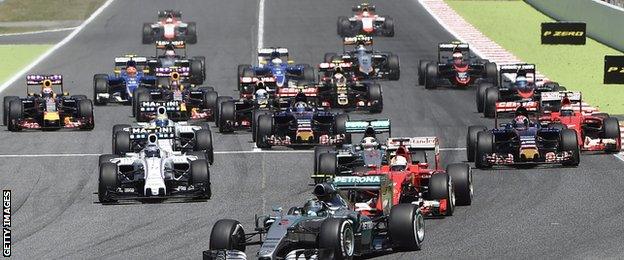Formula 1: Refuelling to return from 2017 season
- Published

Refuelling was last permitted in Formula 1 between 1994 and 2009
Formula 1 bosses have agreed to bring back refuelling in 2017 as part of a range of measures aimed at making the sport more exciting.
There will also be higher revving and louder engines and changes aimed at making cars "five to six seconds a lap faster", governing body the FIA said.
For 2016, bosses have approved a plan to allow teams free choice of the four available tyre compounds for each race.
The changes still need to be approved by two further legislative stages.
The changes were agreed on Thursday at a meeting of the F1 strategy group, which comprises FIA president Jean Todt, commercial supremo Bernie Ecclestone and the Ferrari, Mercedes, McLaren, Red Bull, Williams and Force India teams. The engine manufacturers were also represented at the meeting.
The FIA statement added that a "comprehensive proposal to ensure the sustainability of the sport has emerged".
This, it said, would be refined by the teams in the coming weeks.

There has been criticism of the spectacle provided by F1 in recent years
The engine rules, which saw the introduction of turbo hybrid engines and a fuel restriction last year, will remain stable.
This is to give clarity for any potential new manufacturers who may be considering entering the sport.
But it is the return of refuelling which will attract the most attention - the practice was last permitted in 2009.
Mercedes F1 boss Toto Wolff said: "We discussed many topics. Refuelling was banned because of cost and because the pit stops were taking too long. But we want to re-explore it and see if we can make pit stops for fuel and tyres happen in the same time it takes to change the tyres now - two to three seconds.
"We have agreed to explore this avenue and the cost involved because it could be spectacular. If it's too expensive, we won't do it."
The FIA said a "maximum race fuel allowance" would be retained. Wolff said there had been no discussion of increasing the current allowance of 100kg. He and the FIA said the maximum fuel-flow rate of 100kg per hour would stay.
There has been mounting criticism of the spectacle provided by F1 in recent years and the developments are a clear attempt to address that.
Drivers have been critical that the cars are too slow - in some races they are up to 10 seconds slower than in 2004.
The FIA said this would be addressed for 2017 by "aerodynamic rules evolution, wider tyres and a reduction in car weight".
Wolff said: "We have agreed to increase the width of the cars and tyres, and have larger front and rear wings. We want to ban the driver-aid aspect of starts, so no pre-calibrated starts and have the drivers start using hand clutches.
"For now, it will be an evolution of the current cars. But there is an appetite for more spectacular aero kit. We want to follow this up but at the moment we will go for evolution and that gives us six months to agree on a more spectacular design."

Tyre supplier Pirelli currently chooses two types of tyre for each track out of the four compounds they supply
The first step in improving the show will come with the freedom of tyre choices by teams next year.
Tyre supplier Pirelli said at the weekend that it had reservations about the idea but bosses have ignored this and voted it through.
They feel that providing free tyre choice will introduce variety and uncertainty into race strategy.
The FIA statement said: "All parties agreed to work together with an intention to firm up these proposals and submit them to the approval of the F1 commission and the World Motor Sport Council of the FIA as soon as possible for implementation."
A plan to allow drivers to use a fifth engine this season, one up from the current limit of four, has been rejected.
- Published15 May 2015
- Published15 May 2015

- Published15 May 2015

- Published18 December 2015

- Published2 November 2018

- Published26 February 2019
